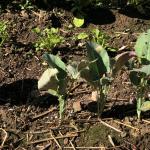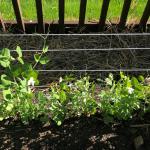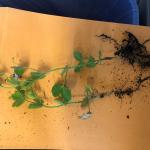Diseases in Your Garden
Frank Mangan and Heriberto Godoy-Hernandez
To read individual sections of this article, click on the section headings below to expand the content:
Welcome to this ninth article of Franco and Beto’s series on growing your own vegetables and herbs in Massachusetts. In this column, we focus on managing disease problems in gardens.
Managing Disease Problems
In my experience, diseases are the most difficult of the three major pest categories to manage in your garden. To begin with, many diseases are not easy to identify, which is the first step in managing a pest using IPM (Integrated Pest Management). Furthermore, the same disease can manifest itself differently on different plants, or different diseases can look similar, further confusing the issue. This is not the case, for example, with the three lined potato beetle described in the previous article. There was no doubt in that case what is was.
Diseases are caused by microbes (bacteria, fungi, and viruses) that infect the plant roots, leaves, or fruit. Some diseases cause plants to be stunted, to wilt, to have spots on the leaves or stems, or the fruit to rot. For a a comprehensive fact sheet on managing diseases in gardens produced by UMass, see Disease Management in the Home Vegetable Garden. You’ll see a focus of this fact sheet for managing diseases on your plants is prevention, as described in another article in this series. Some of the strategies suggested that are relevant in the garden are:
- Reduce leaf wetness: use drip irrigation, increase plant spacing, prune excess foliage
- Sanitation: remove dead or diseased leaves or plants, use clean equipment and tools, sanitize seedling trays between uses or do not reuse, remove crop residues at the end of the season
- Use resistant varieties: some varieties are bred to have resistance to certain diseases (tomatoes and cucumbers are examples of crops for which there are many available)—choose these whenever possible
So far this season, in my garden I have had two disease issues that have been identified by a plant pathologist at UMass. One was on peas, that I noticed as a potential issue in early-May, and the second was on some brassica vegetables, which I observed as a potential issue starting in mid-May.
1. Suspected Disease in Peas
On May 29, I noticed some of the pea plants in my garden were stunted (Figure 1). I sent pictures to our UMass Plant Diagnostic Lab, which instructed me to submit a sample. You can submit your own samples by following the instructions listed on the lab's website.
I removed two pea plants from my garden, one that looked healthy and one that was stressed (Figure 2), making sure to include roots for both. It can help a plant pathologist to identify the issue by comparing healthy plants and stressed ones, if possible. (One can see the pea root system on the top of Figure 2 is much more robust than the one on the bottom. The plant on the top looked healthy in the garden and the one on the bottom was stunted.)
From the report from the diagnostic lab, I learned that my plants had Pythium root rot, that there was no cure for the disease once it got started, and that I could minimize disease by not watering too much and increasing plant spacing next time around (thought I had spaced the plants appropriately).
2. Suspected Disease on Brassica Plants
 The symptoms on the brassica plants were more dramatic than those of the peas (Figure 3). After sending pictures and again submitting samples to the lab as described above, the report from the lab again showed that the plants had a type of Pythium root rot and recommended that I remove all the plants that were showing signs of this disease to prevent it from spreading to other plants. After following this recommendation, I have not seen any more disease issues in this bed, or with any other vegetables or herbs in my garden.
The symptoms on the brassica plants were more dramatic than those of the peas (Figure 3). After sending pictures and again submitting samples to the lab as described above, the report from the lab again showed that the plants had a type of Pythium root rot and recommended that I remove all the plants that were showing signs of this disease to prevent it from spreading to other plants. After following this recommendation, I have not seen any more disease issues in this bed, or with any other vegetables or herbs in my garden.

